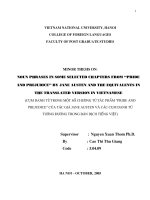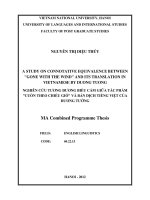A study on historical and social background and the newness of language use in ‘Pride and Prejudice’ by Jane Austen
Bạn đang xem bản rút gọn của tài liệu. Xem và tải ngay bản đầy đủ của tài liệu tại đây (160.23 KB, 4 trang )
A study on historical and social background and
the newness of language use in „Pride and
Prejudice‟ by Jane Austen
Nguyễn Kim Oanh
Trường Đại học Ngoại ngữ
Luận văn Thạc sĩ ngành: English Linguistics; Mã số: 60 22 15
Người hướng dẫn: Dr. Phạm Đăng Bình
Năm bảo vệ: 2012
Abstract. The study firstly aimed at giving some certain information about the
temporary English society and literature of the early eighteenth and late nineteenth
centuries. Secondly, Jane Austen‟s distinctive writing style was thoroughly discussed
through the language use in three leading conversations between the two main
characters -Darcy Fitzwilliam and Elizabeth Bennet - in her „Pride and prejudice‟,
which satired the vices of her society, as portraying the concepts of „sincerity and
vulgarity‟; so powerful that none could escape from. The result of the study briefly
expressed the researcher‟s own viewpoint about the matter of love and love expressing;
as well as major findings and contributions were also stated to recommend a number of
things for readers to consider in the choice of widening their knowledge in literature.
Keywords. Ngôn ngữ; Tiếng Anh; Sử dụng ngôn ngữ
Content
This initial part stated the problem and the rationale of the study, together with the aims,
objectives, the scope of the study, and the overview of the rest of this research paper. Above all,
it was in this part that the research question was identified to work as clear guidelines for the
whole research.
1. Rationale of the study
In the eighteenth century, the readers were delighted by a new form of prose, which was called
„novel‟ for the first time by Daniel Defoe – the first considerable British novelist. A „novel‟ with
a certain length did bring amusement, pleasure and joy to those who were concerned when the
contemporary British society was dreadfully chaotic in the virtue of the changes in the monarch.
In the innovation of this new form of prose, there appeared a remarkable number of writers and
their works. They were coined to emphasize not only the social changes but also the imaginary
stories, which exposed their hope for a better life, so even the family or social class problems
were best put down in words by one of the most famous female novelist in Britain and all over
the world – Jane Austen.
Peter Washington in his commentary once implied that Jane Austen belonged to the fantastic
side of the English comedy that appealed so strongly to the readers, not only in Britain but also
from all over the world.
She was also said to be the first novelist capable of “conveying both interior and exterior of
human life” as well as “developing the means of representing the totality of human life” (Ian
Watt, 1957)
In the six novels written during the very last decades of the eighteenth century, she truly
succeeded in describing “the involvements and feelings and characters of ordinary life which to
me the most wonderful I‟ve ever met with … that a pity such a gifted creature dies so early” as
Walter Scott (1826) once stated in his commentary. All the certain circumstances were just
within the leading involvement of one family and their neighbours and friends in which Austen
created “some heroines who were credible with minds, with the capacity to think for themselves
with ambition and wit”; and „Pride and Prejudice‟, the novel about marriage, was said to be the
best of them all.
„Pride and Prejudice‟ was coined to construct the frame of the contemporarily social satire,
within the relationship between people from the middle and upper classes. It initially commenced
the era of „country family novels‟ which set a “prying inquiry into the manner, human dignity
and great strain” on the characters and the society they were living in, which made her novels
connected to the contemporary world more than the traditional society of the eighteenth century
as Diệp Minh Tâm (2002) once commented.
Further more, it ranked one of the greatest novels of all time following “Wuthering heights” by
Emily Bronte - 1847) and was read even if it was not taught at school. The researcher was
impressed by the name of the novel at first and became overexcited about the novel since she
finished reading it for the first time. The novel was really linked to both of the real world and the
emotional changes inside individuals, especially the female. Therefore, putting extra effort in
investigating what impressed her really fed her desire to understand the people and society at the
time.
2. Aims of the study
This study was carried out with the hope of exploring the background of the temporary Britain
leading to the remarkable changes in its literal history of the eighteenth and nineteenth centuries
especially in the view on British novels.
The study also aimed at answering the question: “What is Jane Austen‟s distinctive writing
style?”. The answer to the question would help the students of Linguistics, the novel's readers as
well as those who wished to specialize in English Literature realize what made Austen one of the
most successful female novelist of the century.
Right from the start, the researcher expected to find out the historical and social background of
the British Literature and briefly analyze the language use in „Pride and Prejudice‟ which
exposed Austen‟s distinctive writing style.
Last but not least was the researcher‟s desire to understand the novel, which was really related to
the controversial matter of love and love expressing.
3. Methodology of procedures
3.1. Design of the study
The study was divided into three main parts. While Part One dealt with the general information
which contained the rationale, aims and objectives, methodology and scope of the study, Part
Two went into further details of the historical and social background; and the newness of
language use in Jane Austen‟s Pride and Prejudice through four chapters. The suggestions for
further research would not be omitted in the last part.
3.2. Data collection and data analysis
The study used the descriptive and contextual methods of data collecting and analyzing.
Basing on the huge resources of library and internet materials, the researcher analyzed and then
agglutinated those ideas into her own brief clear and understandable viewpoints.
On the other hand, several differences in the changeable literal trends of the eighteenth and
nineteenth centuries would be briefly stated in her Analysis on how main characters exposed
their own „pride‟ and „prejudice‟ in some certain circumstances through the three volumes.
4. Scope of the study
As could be seen from the title, the study strongly focused not only on the historical and social
background but also on the language use of the novel which played the most important role.
To understand that newness of language use in the novel, the researcher had to pay her full
attention to the main characters‟ leading conversations in the three volumes which helped expose
the cherish love and the theory of „pride‟ and „prejudice‟ – the main themes of the novel.
Amongst the three conversations, the first two would be thoroughly analyzed, for the reason that
the first „conversation‟ brought the two main characters by their mistaken first impression and
the second conversation was about the conflicts finally resolved.
References
Vietnamese
1. Diệp Minh Tâm, (2002). Kiêu hãnh và định kiến. NXB Hội nhà văn.
2. Nguyễn Hòa, (2006). Phân tích diễn ngôn phê phán: lý luận và phương pháp, NXB. Đại
học Quốc gia Hà Nội, Hà Nội.
3. Đỗ Hữu Châu & Nguyễn Việt Hùng, (2008). Giáo trình Ngữ dụng học. NXB Đại học Sư
phạm.
4. Nguyễn Chí Trung, (2002). English Literature. NXB Giáo dục.
5. Nguyễn Đức Dân, (1998). Ngữ Dụng học. NXB Giáo dục.
English
1. Alexander, M. & Halliday, K. & Hasan, R. (1985). Language, context, and text: aspects
of language in a social-semiotic perspective. Deakin University Press.
2. Austen, J. (1991). Pride and Prejudice. Alfred A. Knopf. New York.
3. Austin, J. L. (1962). How to do things with words. Oxford: OUP.
4. Austin, J. L. (2005). Jane Austen and the important of being wrong. Boston University.
5. Bailey, L. (2012). Re-Approaching the Jane Austen You Knew in High School as an
Adult. Awesome Inc.
6. Berglund, B. (1993). Women‟s whole Existence. Lund University Press.
7. Birdsall, S.V. (1992). English history. McGraw-Hill, Inc.
8. Brown, G. & Yule, G. (1983). Discourse Analysis. Cambridge University Press.
9. Canual, M. (2005). Jane Austen and the important of Being wrong. Boston University
Press, 44-2.
10. Moses, C. (2003). Jane Austen and Elizabeth Bennet: The limits of Irony. Jane Austen
Journal, 25.
11. Christensen, T. (2000). Love is a matter of … . EMI Group.
12. Colebrook, C. (2004). Irony. New Fetter Lane, London.
13. Clark, J. & Carlson, T. (1982). Hearers and Speech Acts. Language 58-2.
14. Clark, H.H. (1992, 2000). Arenas of language use. University of Chicago Press,
Chicago.
15. David, W.R. (1915). The Elements of Style: An Introduction to Literary Criticism.
Forgotten Books.
16. Dorothy, E. (1970). The concise Oxford dictionary of English Literature. Clarendon
Press.
17. Freeman, D.C. (1970). Linguistics and literary style. Literary Criticism.
18. Halliday, M. A. K. (1978). Language as social semiotic-The interpretation of language
and meaning. London. Edward Arnold.
19. Halliday, M. A. K. (1989). Context of situation. In Michael Halliday and Ruqaiua Hasan,
eds., Language, Context and Text: Aspects of Language in a Social-Semiotic Perspective.
Oxford: Oxford University Press, 3-14.
20. Kenneth, O.M. (1997). The Oxford illustrated history of Britain. OUP.
21. Levinson, S.C. (1983). Pragmatics. Cambridge: OUP.
22. Mackaye, S. (1906). Pride and Prejudice, A play found on Jane Austen‟s novel. Duffield
and Company, New York.
23. Margaret, A.R. (1979). Parody// Meta-Fiction. British Library.
24. Mitchell, A. & McGee, K. (2011). Writing in Style: Pattern Languages and Writing Short
Fiction. Story Worlds: A Journal of Narrative Studies, 3:139-160
25. Mitchell, M. (1939). Gone with the wind. Macmillan Publisher.
26. Nunan, D. (1993). Introducing discourse analysis. Penguin English.
27. Peter, W. (1996). Jane Austen. Sanditon and other stories. Graohischer Grossbetrieb
Possneck GmbH – Germany.
28. Ray, K. (20120). The Use of Irony in Jane Austen's 'Pride and Prejudice'. GRIN Verlag
GmbH
29. Richetti, J. (1994). The Columbia history of the British novel. CUP. New York.
30. Qaisar, I. J. (2010). Jane Austen's Pride and Prejudice. A Critical Analysis. Attribution
Non-commercial, retrieved from />Pride-and-Prejudice-A-Critical-Analysis-by-Qaisar-Iqbal-Janjua
31. Strunk, W. & White, E. B. (2000). The Elements of Style (4th Edition). Boston: Allyn
and Bacon.
32. Watt, I. (1957). The Rise of the Novel: Studies in Defoe, Richardson and Fielding.
University of California Press.
33. Wolfe, J. (1999). Jane Austen and the Sin of Pride. Renascence Essays, 51.
Websites:
1.
2.
3.
4.
5. />summary.html
6.
7.
8.
9. />language-and-relationships/
10. />Analysis-by-Qaisar-Iqbal-Janjua









